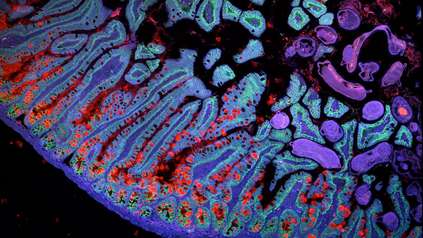Immune cell characteristics mapped across multiple tissues, from early life to adulthood
Previously underexplored immune cell populations have been mapped across multiple tissues in development and adulthood to provide new insights into how our immune system works.
Two new papers from the Wellcome Sanger Institute, the University of Cambridge and collaborators have created open-access atlases of the immune cells in the human body. One study focuses on the early development of the immune system and the localisation of immune cells across several tissues. The other study looks at immune cells in multiple tissues from adult individuals, providing a framework for prediction of cell type identity and insights into immunological memory.
These studies are part of the international Human Cell Atlas (HCA) consortium, which is aiming to map every cell type in the human body as a basis for both understanding human health and for diagnosing, monitoring, and treating disease. An open, scientist-led consortium, HCA is a collaborative effort of researchers, institutes, and funders worldwide, with more than 2,300 members from 83 countries across the globe.
Published today (12 May 2022) in Science, both studies explore the similarities and differences of immune cells across different tissues, which are understudied, compared to those circulating in the blood. Knowing more about immune cell traits and reactions in these tissues at different stages of life could help future research into therapies that aim to produce or enhance an immune response to fight disease, such as vaccinations or anti-cancer treatments.
These papers are two of four major studies published in Science this week, which have created comprehensive and openly available cross-tissue cell atlases. The complementary studies shed light on health and disease, and will contribute towards a single Human Cell Atlas.
The human immune system is made up of many different types of cells that can be found throughout the body, all playing crucial roles. They not only fight off pathogens when they appear, but remember them so they can be eliminated in the future.
In the first study*, researchers from the Wellcome Sanger Institute and collaborators created an atlas of the developing human immune system across nine organs. They used spatial transcriptomics and single-cell RNA sequencing to map the exact location of specific cells within developing tissues. Researchers were able to identify a new type of B cell, and distinctive T cells that appear in the early stages of life. The team used data from the other Human Cell Atlas study** to prove that these particular immune cells are not found in adults.
“This comprehensive atlas of human immune development reveals tissues involved in the formation of blood and immune cells, enhancing our understanding of immune and blood disorders. In cooperation with the other studies it enables mapping of the immune system from development to adulthood, revealing cell types that are lost as we grow up. It also helps to inform cell engineering and regenerative medicine research.”
Professor Muzlifah Haniffa, a senior author on the first study from Wellcome Sanger Institute and Newcastle University
In the second study**, scientists from the Wellcome Sanger Institute, the University of Cambridge, and their collaborators simultaneously analysed immune cells across 16 tissues from 12 individual adult organ donors. The team developed a database and algorithm that automatically classifies different cell types, called CellTypist, to handle the large volume and variation of immune cells. Through this, they were able to identify around 100 distinct cell types.
Using CellTypist and further in-depth analysis, the researchers created a cross-tissue immune cell atlas that revealed the relationship between immune cells in one tissue and their counterparts in others. They found similarities across certain families of immune cells, such as macrophages, as well as differences in others. For example, some memory T cells show unique features depending on which tissue they are in.
“We have created a catalogue of immune cells within the adult human body, allowing us to automatically identify cell types across multiple tissues. By using single-cell sequencing data we have been able to reveal around a hundred different kinds of immune cells including macrophages, B cells, and T cells, uncovering crucial information about how the immune system works. We would like to thank the donors and their families for making this research possible.”
Dr Cecilia Domínguez Conde, co-first author of the second study, from the Wellcome Sanger Institute
“In this research, we not only identified distinct types of immune cells, we also found that certain immune cell types follow specific tissue distribution patterns. Understanding the varying behaviours of the same type of immune cell in multiple areas of the body can help inform research into disease and how treatments that target these cells might impact other tissues.”
Dr Joanne Jones, co-senior author of the second study, from the University of Cambridge
The wider research community can freely use these cross-tissue immune cell atlases to help interpret and inform future research. Having a complete cell atlas could serve as a framework to identify which immune cells could be useful to activate when designing new therapeutics that focus on guiding or supporting the immune system, such as vaccination and immunotherapies, for both infectious diseases and solid tumours.
“Our multi-tissue immune cell atlases are a step towards understanding how the immune system functions throughout the entire body at different stages of life and are an important contribution towards the Human Cell Atlas. A detailed understanding of cells through the Human Cell Atlas will help explain many aspects of human health and disease. In addition to creating a new resource for researchers to classify different cell types, our work will have many translational implications, including serving as a framework for developing therapies to fight immune-related diseases and managing infections.”
Dr Sarah Teichmann, co-senior author on both studies from the Wellcome Sanger Institute, and co-founder of the Human Cell Atlas
More information
Further information on immune cells:
Immune cells can be spilt into various groups depending on their function and how they are activated. For example, macrophages surround and kill microorganisms and remove dead cells, and are a part of the innate immune system, so they attack anything they do not recognise.1
On the other hand, T cells and B cells are activated when they recognise markers on or released from pathogens, known as antigens. T cells identify and attack pathogens with antigens on their cell surface, known as cell-mediated immunity, while B-cells produce antibodies to target antigens that are freely circulating in the blood.2
- British Society for Immunology. Macrophages. Available at https://www.immunology.org/public-information/bitesized-immunology/cells/macrophages#:~:text=Macrophages%20are%20specialised%20cells%20involved,cytokines)%20that%20activate%20other%20cells. [Accessed April 2022]
- MSD Manual. Overview of B- and T-Cell Function. Available at https://www.msdmanuals.com/professional/multimedia/video/overview-of-b-and-t-cell-function [Accessed April 2022]
Tools:
CellTypist is publicly available, with user-friendly documentation for automatically annotating immune cells in single cell transcriptomics datasets (www.celltypist.org).
Publication:
*Chenqu Suo, Emma Dann, Issac Goh, et al. (2022) Mapping the developing human immune system across organs. Science. DOI: 10.1126/science.abo0510
**Domínguez Conde. C, Xu. C, Jarvis. LB, Rainbow. DB, Wells. SB, et al. (2022) Cross-tissue immune cell analysis reveals tissue-specific features in humans. Science. DOI: 10.1126/science.abl5197
Funding:
The first study* was funded by Wellcome, the Chan Zuckerberg Initiative, the MRC Human Cell Atlas award, and Wellcome Human Developmental Biology Initiative. A full funding list can be found on the publication.
The second study** was funded by Wellcome, the Chan Zuckerberg Initiative, and the National Institutes of Health (NIH). A full funding list can be found on the publication.





